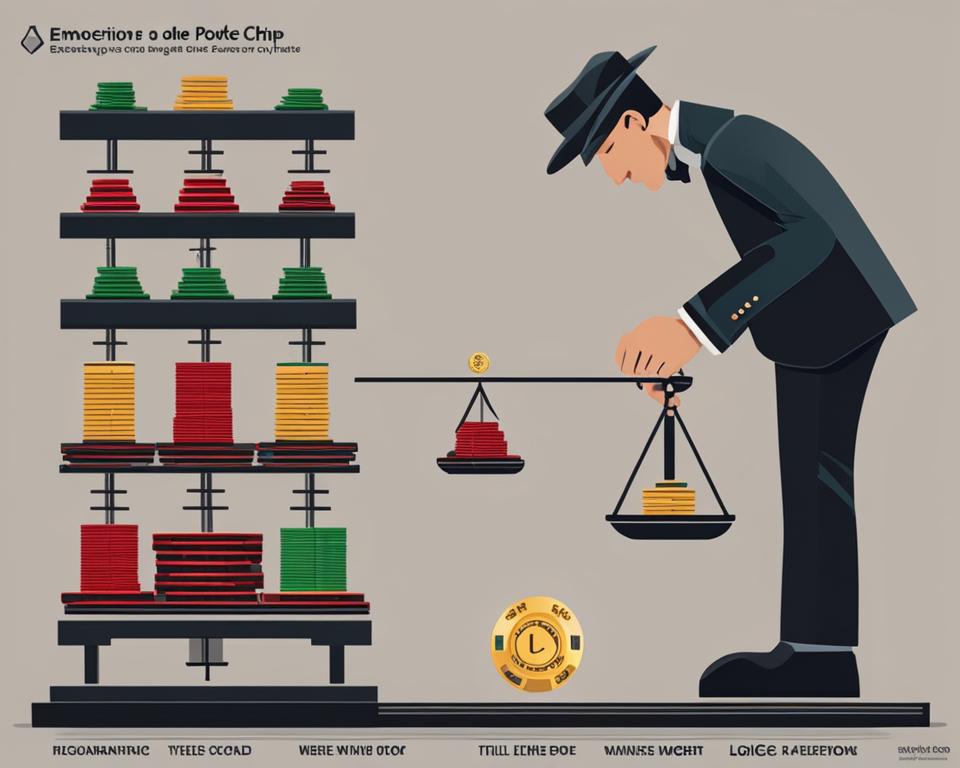Becoming a successful poker player requires more than just skill and strategy. One of the key elements to long-term success in the game is proper bankroll management. Whether you’re a beginner or an experienced player, understanding how to effectively manage your poker bankroll is essential for sustained growth and enjoyment of the game.
Bankroll management refers to how you manage your available finances for playing poker. By following some basic rules and strategies, you can ensure that you always have money left over for future poker sessions and minimize the frustration of constantly having to deposit more money into your account.
Establishing sound bankroll management principles from the beginning sets the foundation for your poker journey. This article will provide you with valuable tips and strategies to get you started on the right track. Whether you play online or live, cash games or tournaments, these principles apply across the board.
Ready to take your poker game to the next level? Let’s dive into the world of poker bankroll management.
Key Takeaways:
- Proper poker bankroll management is essential for long-term success in the game.
- It helps ensure you always have money left over for future poker sessions.
- By only playing with money you can afford to lose and treating your bankroll as an investment, you can effectively manage your poker bankroll.
- Keeping track of your sessions and learning from your mistakes are crucial for sustained growth in the game.
- Follow some basic rules, such as selecting games that match your skill level and accepting variance as part of the game.
The Importance of Poker Bankroll Management
Poker bankroll management is vital for several reasons. It allows you to have control over your finances when playing poker and prevents you from wasting all your money in one session. It also helps you navigate the variance in poker, as the game can be unpredictable and luck can play a role in the outcome of each hand. By practicing good bankroll management, you can minimize frustration and disappointment and maintain control over your finances in the game.
The Basics of Poker Bankroll Management
When it comes to poker bankroll management, beginners should follow some basic rules to ensure sustainable growth and success in the game. By implementing these principles, players can effectively manage their finances and enjoy a fulfilling poker experience.
Key Principles of Poker Bankroll Management:
- Play with the money you can afford to lose: It is essential to only use funds that you are comfortable losing. This approach allows you to play without financial stress and ensures that your bankroll remains intact even during downswings.
- Treat your bankroll as an investment: Viewing your bankroll as a long-term investment helps you make better decisions and avoid impulsive actions based on short-term results. By treating your bankroll with care, you are more likely to make strategic moves that lead to its growth.
- Play at stakes that match your skill level and bankroll size: It is important to play at stakes where you feel comfortable and have a competitive edge. Playing beyond your bankroll’s capacity can lead to unnecessary risks and potential losses. Opting for stakes within your range ensures a smoother gameplay experience.
- Accept variance as part of the game: Poker is a game of skill, but luck also plays a role. Accepting the inherent variance in poker helps you manage the ups and downs without becoming emotionally affected. Maintaining a level-headed approach allows you to make rational decisions based on long-term expectations.
- Select your games carefully: Not all poker games are equal in terms of difficulty and potential return on investment. It is crucial to choose games that offer a suitable skill level and favorable conditions. By carefully selecting your games, you maximize your chances of success while minimizing unnecessary risks.
Patience and discipline are essential attributes when it comes to effective bankroll management. Additionally, tracking and analyzing your poker sessions is a valuable practice that allows you to identify strengths, weaknesses, and areas for improvement.
To illustrate the importance of proper bankroll management, consider the following example:
| Bankroll | Initial Investment | Current Value |
|---|---|---|
| John Doe | $500 | $2,000 |
| Jane Smith | $1,000 | $800 |
“Proper bankroll management allowed John Doe to grow his initial investment by 300%, while Jane Smith faced a setback due to inadequate bankroll management.”
These examples highlight the difference that solid bankroll management can make in a player’s poker journey. It is important to remember that bankroll management is a long-term strategy and may involve periods of both growth and decline. However, with discipline and careful decision-making, players can navigate the ups and downs of the game while steadily growing their bankrolls.
Next, we will discuss strategies for effectively managing your poker bankroll to minimize the risk of going broke and maximize your chances of long-term success. Stay tuned!
Managing Your Poker Bankroll
Managing your poker bankroll is essential to ensure a sustainable and successful poker journey. It goes beyond simply depositing a fixed amount into your account. Your bankroll size determines the level of games you can safely play, and effective bankroll management minimizes the risk of going broke. By implementing proper strategies and following key principles, you can protect and grow your poker bankroll, allowing you to enjoy the game without financial stress.
One important aspect of managing your poker bankroll is knowing when to move down to lower stakes. If you experience a significant losing streak or lose a predetermined amount of money, it’s crucial to adjust your stakes accordingly. This ensures that you have enough buy-ins for your cash games or tournaments, reducing the risk of exhausting your funds and going broke. Remember, playing at lower stakes is always better than being unable to play at all.
The Benefits of Proper Bankroll Management
Proper bankroll management offers several benefits, including:
- Minimizing Risk: By effectively managing your bankroll, you minimize the risk of losing all your funds in a single session or experiencing a major financial setback. This allows for a more stable and enjoyable poker experience.
- Long-Term Growth: Bankroll management helps your poker bankroll grow steadily over time. By practicing discipline and not taking unnecessary risks, you increase your chances of sustained success and profitability in the game.
- Reducing Stress: By knowing that your bankroll is being managed properly, you can enjoy the game without constantly worrying about going broke. This reduces stress and allows you to focus on making optimal decisions at the tables.
Effective bankroll management is all about finding the right balance between playing at stakes that are both challenging and within your financial means.
Poker Bankroll Management Tips
Here are some practical tips to help you manage your poker bankroll effectively:
- Set a Budget: Allocate a specific amount of money for your poker bankroll that you can comfortably afford to lose. This ensures that you don’t risk more than you can handle and protects your financial stability.
- Choose the Right Stakes: Play at stakes that are appropriate for your skill level and bankroll size. Avoid playing above your means, as this increases the risk of significant losses. As a general rule, it’s recommended to have at least 20-25 buy-ins for cash games and 50-100 buy-ins for tournaments.
- Track Your Performance: Keep a record of your sessions, including wins, losses, and expenses. This allows you to analyze your performance, identify areas for improvement, and make informed decisions about your bankroll management.
- Practice Discipline: Stay disciplined and avoid taking unnecessary risks, such as playing at higher stakes during a downswing or chasing losses. Stick to your bankroll management plan and trust the process.
- Continuously Educate Yourself: Stay updated with the latest poker strategies and bankroll management techniques. Attend training courses, read books, and follow reputable poker resources to enhance your knowledge and improve your bankroll management skills.
| Stake Level | Bankroll Requirement |
|---|---|
| Micro Stakes (NL2-NL10) | 20-25 buy-ins |
| Low Stakes (NL25-NL50) | 30-40 buy-ins |
| Mid Stakes (NL100-NL200) | 40-50 buy-ins |
| High Stakes (NL500+) | 50+ buy-ins |
Remember, these are general guidelines, and individual circumstances may vary. It’s crucial to assess your own risk tolerance, skill level, and goals when determining your personal bankroll requirements.
Bankroll Recommendations for Different Game Formats
Proper bankroll management is essential for poker players of all levels. To ensure that you have enough funds to withstand the ups and downs of different game formats, it’s recommended to follow specific bankroll guidelines. These recommendations have been developed by the poker community and offer a general framework for managing your bankroll effectively.
Online NLH Cash Games
For online No-Limit Hold’em (NLH) cash games, it’s recommended to have a bankroll of at least 100 buy-ins. This ensures that you have enough funds to handle the swings and variations that can occur during cash game sessions.
Online MTTs
If your focus is on online multi-table tournaments (MTTs), it’s advisable to have a larger bankroll due to the higher variance involved. The recommended bankroll size for online MTTs is 250 buy-ins, as this provides a buffer against unlucky stretches and allows for sustained participation in tournaments.
Live Cash Games
For live cash games, where the pace is typically slower than online games, a bankroll of 30 buy-ins is generally recommended. This ensures that you have enough funds to comfortably play at the desired stakes and minimizes the risk of going broke.
Single Table SNGs and Heads-Up SNGs
For single table Sit-and-Go tournaments (SNGs), it’s recommended to have a bankroll of 75 buy-ins. This provides a cushion against downswings and allows for continued participation in these tournaments. For heads-up SNGs, which can be especially volatile, a bankroll of 30 buy-ins is typically advised.
Live Tournaments
Live tournaments, with their high buy-ins and potential for significant payouts, require careful bankroll management. The recommended number of buy-ins for live tournaments ranges from 20 to 100, depending on the specific circumstances. Factors such as the size of the field, the level of competition, and the desired level of comfort should be taken into account when determining your bankroll for live tournaments.
It’s worth noting that these recommendations serve as general guidelines and can vary based on individual circumstances and risk tolerance. Additionally, players with a higher skill level may require a smaller bankroll to handle the natural variance of the game. It’s important to assess your own situation and adjust these recommendations accordingly.
By following these bankroll recommendations, you can mitigate risk, manage variance, and ensure that you have the necessary funds to actively participate in various game formats. A disciplined approach to bankroll management is key to long-term success in poker.
Tailoring Bankroll Management to Your Situation
Your approach to bankroll management should be tailored based on your goals and financial situation. Whether you are a professional poker player or a recreational player, your bankroll management strategy will differ.
If you rely on poker as a source of income or aspire to become a professional player, it is crucial to treat your bankroll as a tool to make money. Professionals need to have a larger bankroll to support their preferred stakes and handle the ups and downs of the game. They should prioritize building a solid bankroll to sustain their professional poker career.
However, if you have a stable source of income outside of poker and primarily play for entertainment, you can take a more relaxed approach to your bankroll management. Recreational players can afford to take occasional risks in higher variance games, knowing that their bankroll is not solely dependent on poker winnings.
Regardless of whether you are a professional or recreational player, proper bankroll management is essential. It helps you maintain control over your finances, minimize the risk of going broke, and ensure sustainable play in the long run.
Bankroll Management for Professionals
For professional players, poker bankroll management is a critical aspect of their success. Here are some key considerations:
- Build a substantial bankroll: Professionals should aim to have a bankroll that can comfortably sustain their chosen stakes. This provides a cushion for downswings and allows for consistent play.
- Track expenses and income: Keeping a detailed record of your expenses and income from poker is crucial for evaluating your progress and making informed decisions about your bankroll.
- Manage risk carefully: Professionals should be conservative with their bankroll and avoid unnecessary risks. Playing within their limits and sticking to solid bankroll management principles is essential for long-term success.
Bankroll Management for Recreational Players
As a recreational player, your bankroll management strategy can be more flexible. Here are some tips to consider:
- Determine your playing budget: Set aside a specific amount of money for your poker bankroll that you are comfortable losing. This ensures that your poker play remains within your financial means.
- Enjoy the game responsibly: Since poker is primarily a form of entertainment for recreational players, you can be more relaxed with your bankroll. Taking occasional risks in higher variance games can add excitement, but remember to stay within your bankroll limits.
- Focus on skill development: While recreational players may not have the same financial pressures as professionals, it’s still important to work on improving your poker skills. Investing time in studying the game and refining your strategy can enhance your overall poker experience.
By tailoring your bankroll management approach to your situation, you can find the right balance between financial responsibility and the enjoyment of playing poker. Remember, regardless of your playing style, practicing discipline, and following a bankroll management strategy is key to long-term success.
Tips for Effective Bankroll Management
To effectively manage your poker bankroll, it’s important to follow some key tips. By implementing these strategies, you can increase your chances of long-term success and minimize unnecessary risks.
Set a Specific Budget
One of the fundamental principles of bankroll management is setting a specific amount of money that you can afford to play with. This budget should be separate from your essential expenses and other financial obligations. By doing so, you can ensure that your poker bankroll is protected and that you won’t be risking money you can’t afford to lose.
Treat Your Bankroll as an Investment
Instead of viewing your bankroll as disposable income, think of it as an investment in your poker career. Similar to how you carefully manage and grow investments, apply the same mindset to your bankroll. Avoid unnecessary risks and only invest in games that provide favorable opportunities for profit. This disciplined approach will help protect and grow your bankroll over time.
Match Stakes to Your Skill Level and Bankroll Size
Playing at stakes that align with your skill level and bankroll size is crucial for maintaining a sustainable bankroll. If you consistently play at stakes higher than what you’re comfortable with, you increase the risk of losing significant portions of your bankroll. On the other hand, playing at stakes that are too low may limit your earning potential. Finding the right balance is essential for bankroll growth and long-term success.
Accept Variance and Make Good Decisions Despite It
Poker is a game of skill, but luck and variance will always play a role. It’s important to understand and accept that you can experience both upswings and downswings in your bankroll. During downswings, it’s crucial to maintain discipline and make good decisions based on sound poker strategy, rather than getting emotionally affected by short-term results. By focusing on long-term success and making optimal choices, you can navigate through variance with confidence.
Select Your Games Carefully
Not all poker games are created equal, and as a responsible bankroll manager, it’s crucial to be selective about the games you choose to play. Assess the level of competition, game format, and potential profitability before jumping into a game. By doing your research and identifying games with favorable conditions, you can maximize your chances of success and protect your bankroll.
Practice Patience and Discipline
Patience and discipline are two key qualities for effective bankroll management. Avoid impulsive decisions and stick to your bankroll management plan, even during times of temptation or frustration. By maintaining discipline, you can avoid unnecessary risks and ensure steady bankroll growth over time. Additionally, practicing patience allows you to wait for favorable opportunities and minimize losses during unfavorable situations.
Track Your Sessions and Learn from Mistakes
Keeping track of your poker sessions is essential for improving your bankroll management skills. After each session, review your hands, decisions, and results. Identify any mistakes or areas for improvement and make adjustments accordingly. This self-analysis and continuous learning will contribute to your overall growth as a poker player and enhance your ability to manage your bankroll effectively.
By following these tips and incorporating them into your poker journey, you can enhance your bankroll management skills and increase your chances of long-term success in the game.
Bankroll Management Tools and Apps
Managing your poker bankroll effectively is essential for long-term success in the game. Fortunately, there are various tools and apps available to assist you in this process. These tools not only help you keep track of your sessions but also provide valuable insights into your performance and areas for improvement.
Bankroll Tracking Software
One of the most useful types of tools for managing your poker bankroll is bankroll tracking software. These applications allow you to record and analyze your session data, helping you make informed decisions about your bankroll management. Some of the popular bankroll tracking apps include:
- Poker Bankroll Tracker
- Poker Income Tracker
- Poker Manager
These tools provide features such as session tracking, bankroll analysis, graphing, and expense tracking. By utilizing these tools, you can stay organized and gain valuable insights into your poker bankroll management.
“Bankroll tracking software provides valuable data and analysis that can help players fine-tune their bankroll management strategy and improve their overall performance in the game.” – Poker Pro
With bankroll tracking software, you can easily keep track of your wins, losses, and overall profitability. You can analyze your performance over time and identify any leaks or areas for improvement. This data-driven approach allows you to make adjustments to your bankroll management strategy and ultimately increase your chances of success at the poker tables.
The Psychology of Bankroll Management
Bankroll management in poker goes beyond just crunching numbers and implementing strategies. It also encompasses a significant psychological aspect that requires discipline and careful decision-making. By understanding and mastering the psychological elements of bankroll management, players can enhance their overall poker experience and increase their chances of long-term success.
One critical aspect of psychological bankroll management is discipline. It is essential to have the discipline to stick to a predetermined bankroll and avoid impulsive decisions that could jeopardize your financial stability. This discipline involves playing within your bankroll limits and resisting the temptation to chase losses or play at higher stakes than your bankroll can handle. By following a disciplined approach, you maintain the right mindset and reduce the mental strain of a bad stretch.
Another crucial psychological aspect of bankroll management is the ability to recognize when to move down in stakes during a downswing. Rather than stubbornly persisting at higher stakes in an attempt to recover losses, it is essential to have the humility and self-awareness to rebuild your bankroll gradually. Moving down in stakes allows you to adjust to the current circumstances, regain confidence, and mitigate the risk of further losses.
Proper bankroll management also helps players stay grounded and focused on their long-term goals. It provides a sense of stability and security, knowing that you have taken precautions to protect your bankroll and ensure sustainable play. This psychological confidence translates into more thoughtful decision-making and reduced emotional volatility at the tables.
To summarize, the psychological aspect of bankroll management in poker requires discipline, self-awareness, and a long-term perspective. It’s about valuing every decision you make, recognizing the need for adjustments, and staying mentally resilient in the face of inevitable ups and downs. By incorporating these psychological principles into your bankroll management strategy, you can enhance your overall poker experience and increase your chances of long-term success.

Key Takeaways:
- Bankroll management in poker has a significant psychological component that requires discipline and careful decision-making.
- Discipline is crucial to stick to your predetermined bankroll and avoid impulsive decisions.
- Recognizing when to move down in stakes during a downswing helps protect your bankroll and rebuild gradually.
- Proper bankroll management provides stability, confidence, and a long-term perspective toward sustainable play.
Lessons from Doug Polk’s Bankroll Challenge
Doug Polk’s Bankroll Challenge serves as an inspiring example of effective bankroll management. With a mere $100, Doug demonstrated the power of discipline and strategic decision-making in growing his poker bankroll.
From the start, Doug treated his bankroll as a valuable investment, carefully selecting games that aligned with his skill level and offered the potential for growth. By focusing on games within his limits, he minimized the risk of losing significant amounts and maintained control over his bankroll.
Throughout his challenge, Doug realized the importance of playing within one’s means and avoiding unnecessary risks. While setbacks were inevitable, his commitment to proper bankroll management allowed him to navigate the ups and downs of the game effectively.
“Proper bankroll management is the foundation for sustainable growth in poker,” explains Polk. “By staying disciplined and making calculated decisions, even a small initial investment can lead to significant bankroll growth.”
Doug’s bankroll challenge is a testament to the potential for substantial bankroll growth, regardless of the initial capital. It serves as an inspiration for aspiring poker players, showcasing the benefits of strategic bankroll management and the rewards of disciplined play.
Conclusion
Proper bankroll management is a fundamental aspect of poker that applies to both beginners and experienced players. It serves as the foundation for sustainable play, reduces the risk of going broke, and paves the way for long-term success in the game. By adhering to a few essential guidelines, such as playing with available funds, treating the bankroll as an investment, and cultivating discipline and patience, players can effectively manage their poker bankroll and enjoy a rewarding poker journey.
Poker is a game of skill, but without proper bankroll management, even the most talented players can face significant challenges in making a consistent profit. By respecting their financial limitations, wisely managing their bankroll, and maintaining a steady and calculated approach to the game, players can maximize their chances of success.
Remember, success in poker is a marathon, not a sprint. It requires strategic decision-making and a responsible approach to financial matters. With proper bankroll management, players can weather the ups and downs of the game, mitigate risk, and position themselves for long-term growth.
Key Takeaways:
- Proper bankroll management is essential for all poker players, regardless of skill level.
- Playing with money you can afford to lose and treating your bankroll as an investment are fundamental principles.
- Discipline and patience are essential qualities in effectively managing a poker bankroll.
- Proper bankroll management sets the foundation for sustainable play and long-term success in the game.
“Proper bankroll management is like a silent partner that supports you throughout your poker journey. Treat it with respect, and it will reward you with stability and growth.” – Anonymous
| Benefits of Proper Bankroll Management | Consequences of Poor Bankroll Management |
|---|---|
| – Reduced risk of going broke – Sustained growth in the game – Emotional stability and peace of mind |
– Increased risk of going broke – Emotional distress and tilt – Limited opportunity for growth and progress |

Additional Bankroll Management Resources
If you’re looking for more resources to improve your bankroll management skills, there are various courses and books available on the topic. Investing in your knowledge and understanding of bankroll management can significantly enhance your poker game and help you achieve long-term success at the tables.
Some highly recommended resources include “The Poker Bankroll Bible” by Greg Jones, a comprehensive guide that delves into the intricacies of bankroll management, providing practical strategies and tips to maximize your profitability. “Bankroll Management: How To Manage Your Bankroll Like a Pro” by Marvin Karlins offers valuable insights and techniques from experienced players, enabling you to navigate the ups and downs of poker variance with confidence.
If you’re looking for a specific focus on microstakes, “Crushing the Microstakes” by Nathan Williams is an excellent choice. This book provides detailed advice for building and growing a bankroll from the ground up, particularly in lower-stakes games where proper management is crucial.
For a more interactive and comprehensive learning experience, consider online poker training sites such as Upswing Poker and PokerCoaching.com. These platforms offer in-depth courses on bankroll management, taught by industry experts, along with a range of other valuable poker resources to enhance your overall gameplay.
FAQ
What is bankroll management in poker?
Bankroll management in poker refers to how you manage your available finances for playing poker. It involves establishing principles and rules to ensure you always have money left for future poker sessions and minimize the risk of losing your entire bankroll.
Why is bankroll management important in poker?
Bankroll management is crucial in poker as it allows you to have control over your finances, navigate the variance in the game, and avoid going broke. It helps you maintain a sustainable approach to poker and focus on long-term success rather than short-term fluctuations.
What are some basic rules for poker bankroll management?
Some basic rules for poker bankroll management include playing with only the money you can afford to lose, treating your bankroll as an investment, playing at stakes that match your skill level and bankroll size, accepting variance as a part of the game, and selecting your games carefully.
How should I manage my poker bankroll effectively?
To manage your poker bankroll effectively, you should set a specific amount to play with that you can afford to lose, treat your bankroll as an investment and avoid unnecessary risks, play at stakes that match your skill level and bankroll size, accept variance and not let it affect your decision-making, select your games carefully, and practice patience and discipline.
What are some bankroll recommendations for different game formats?
For online NLH Cash Games, it’s recommended to have 100 buy-ins. For online MTTs, the recommendation is 250 buy-ins. For live Cash Games, it’s 30 buy-ins. Single table SNGs require 75 buy-ins, while heads up SNGs require 30 buy-ins. And for live Tournaments, the recommended number of buy-ins ranges from 20 to 100.
How should I tailor my bankroll management to my situation?
Your approach to bankroll management should consider your goals and financial situation. If you rely on poker as a source of income or aspire to become a professional player, you should treat your bankroll as a tool to make money and have a larger bankroll to support your preferred stakes. If you play poker primarily for entertainment and have a stable source of income outside of poker, you can be more relaxed with your bankroll and take occasional risks in higher variance games.
What are some tips for effective bankroll management?
Some tips for effective bankroll management include setting a specific amount to play with, treating your bankroll as an investment, playing at stakes that match your skill level and bankroll size, accepting variance and not letting it affect your decision-making, selecting your games carefully, and practicing patience and discipline.
Are there any tools or apps available to help with poker bankroll management?
Yes, there are various tools and apps available to help with poker bankroll management. Some popular bankroll tracking apps include Poker Bankroll Tracker, Poker Income Tracker, and Poker Manager. These tools allow you to keep track of your sessions, analyze your performance, and make informed decisions about your bankroll management.
What is the psychological aspect of bankroll management?
Bankroll management has a psychological aspect that requires discipline and the ability to value every decision you make in the game. It helps you stay grounded, maintain the right mindset, and reduce the mental strain of a bad stretch. Proper bankroll management also ensures you are humble enough to rebuild your bankroll and focus on long-term goals.
Can you provide an example of successful bankroll management?
Doug Polk’s Bankroll Challenge is a notable example of successful bankroll management. Starting with just $100, Doug managed his bankroll with discipline, treating it as an investment and avoiding unnecessary risks. Despite facing setbacks, his challenge demonstrated the power of proper bankroll management and the potential for significant growth even with a small initial investment.
Why is bankroll management important for beginners?
Bankroll management is crucial for beginners as it helps ensure sustainable play, minimizes the risk of going broke, and allows for long-term success in the game. By following some basic rules and principles, beginners can establish good habits from the start and focus on improving their skills without the constant pressure of losing their entire bankroll.
Are there any additional resources available to learn more about bankroll management?
Yes, there are various resources available to learn more about bankroll management. Some recommended resources include books like “The Poker Bankroll Bible” by Greg Jones, “Bankroll Management: How To Manage Your Bankroll Like a Pro” by Marvin Karlins, and “Crushing the Microstakes” by Nathan Williams. Additionally, online poker training sites like Upswing Poker and PokerCoaching.com offer comprehensive courses on bankroll management and various other aspects of the game.





